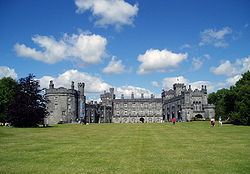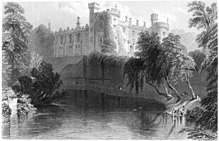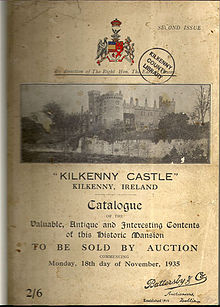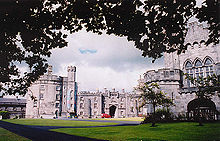Kilkenny Castle
| Kilkenny Castle | |
|---|---|
 |
|
| Data | |
| place | Kilkenny , Republic of Ireland |
| Client | Richard de Clare, 2nd Earl of Pembroke |
| Construction year | 1195-1213 |
| Coordinates | 52 ° 39 '1.6 " N , 7 ° 14' 57.7" W |
Kilkenny Castle ( Irish : Caisleán Chill Chainnigh ) is a castle in Kilkenny , the capital of the county of the same name in the Republic of Ireland . Kilkenny Castle was built from 1195 to 1213 to control a ford through the River Nore and several trade routes. The facilities with originally four strong corner towers and the partially preserved moat were a central part of the city's defenses and are considered a symbol of the presence of the Normans in Ireland.
The castle was sold to the Irish government in 1967 for a symbolic price of £ 50 . It is now managed by the Office of Public Works together with the associated gardens and parks and is open to visitors. One of the four castle towers is used as a conference center.
history
Beginnings among the Earls of Pembroke
On the strategically located hill on the bank of the Nore there was probably a fortification before the 12th century. Kilkenny with the Abbey of St. Canice was the headquarters of the local kings of Osraige from the Mac Giolla Phádraig clan .

As part of the Anglo-Norman conquest of Ireland was Richard de Clare, 2nd Earl of Pembroke , called Strongbow , 1171 with the rule Leinster invested , was one of Kilkenny. The following year he had his first castle built, presumably a wooden moth , but it was destroyed again in 1173 during a revolt of the Gaelic clans. The area remained in the possession of the Earls of Pembroke .
His daughter and heiress Isabel married William Marshal, 1st Earl of Pembroke in 1189 , who thus became lord of large estates in Ireland, England, Wales and France, which he managed efficiently. When Lord of Leinster he made Geoffrey FitzRobert the Seneschal of Leinster, under the brisk construction activity began: the city of Kilkenny was expanded, received a city wall and in 1207 the town charter . Construction of a stone castle began in 1195 and completed in 1213. This castle forms the core of what is now Kilkenny Castle; Erected on a rectangular floor plan, it received four round corner towers, three of which have been preserved to this day.
Marshal bequeathed Kilkenny to his daughter Eva, wife of William de Braose, 7th Baron of Bramber . Through their daughter Eleanor de Braose, who was married to Humphrey V. de Bohun , it came in 1270 to their son Gilbert de Bohun , Seneschal of Kilkenny, the younger brother of Humphrey de Bohun, 3rd Earl of Hereford , who made it up to his Death in 1327. After the death of his descendant of the same name in 1381, the castle fell to the English crown. In 1391 it was sold to the Butler family, Earls of Ormonde , who owned it for more than five hundred years.
Under the Earls of Ormonde
The Butler family had their name changed from Fitz Walter to Butler in 1185. She came to Ireland with the Normans during the Norman invasion . James Butler, 3rd Earl of Ormonde built Gowran Castle at Gowran , which made the family rich. In 1391 he bought Kilkenny Castle, establishing his family as rulers of the castle and its lands. The castle now became the headquarters of the Earls of Ormonde, who later received the titles of Duke and Marquess . However, much of the family, including James Butler, 3rd Earl of Ormonde, was buried in St. Mary's Collegiate Church in Gowran. Other well-known members of the Butler family were Lady Margaret Butler (1454 / 1465-1539) and her father Thomas Butler, 7th Earl of Ormonde . Margaret Butler was born at Kilkenny Castle and later married Sir William Boleyn. Their daughter Anne Boleyn was the second wife of Henry VIII.
In the 17th century, Elizabeth Preston , the wife of James Butler, 12th Earl of Ormonde , who was Lord Lieutenant of Ireland at the time, owned the castle. Unpopular in the family, Butler was a Protestant and represented Charles I in Ireland during the Irish Confederation Wars in the 1640s . Butler went into exile in Dublin , and Kilkenny Castle became the headquarters of the Catholic rebels . The Parliament or "Supreme Council" met at Kilkenny Castle from 1642 to 1648. In 1650, the castle was besieged by an army led by Oliver Cromwell , damaging the eastern wall and northeast tower. The remaining remains of the wall and tower were later torn down. After Butler returned from exile, he rebuilt the castle in 1661 as a "modern palace". Around this time a new entrance gate was built on the south wall. Castles from Normandy served as a model , which is why stone was imported from Caen . Since then, Kilkenny Castle has been called a castle.
In the 18th century the Butler family became impoverished and the castle was run down. Minor restorations were carried out by Anne Wandesford of Castlecomer (1754-1830), heir to the 1st Earl Wandesford , who brought money into his family by marrying John Butler, 17th Earl of Ormonde .

In the 19th century, the members of the Butler family tried harder to renovate the castle and restore it to its medieval splendor. Among other things, they reconstructed the north wing and the facades of the buildings. The building was expanded by several extensions in 1854. The architect was William Robertson .
In 1899 Kilkenny Castle was visited by the future King George V , then Duke of York , and his wife, five years later King Edward VII and his wife Alexandra visited the castle complex.
The castle was continually expanded to become the headquarters of the Marquesses of Ormonde . The expansion ended with the death of James Butler, 3rd Marquess of Ormonde in 1919. Because Lord Ormonde had only two daughters, it was agreed that all property should now be transferred to the nephew of James Butler, 3rd Marquess of Ormonde. Arthur Butler, 4th Marquess of Ormonde , the brother and heir of the 3rd Marquess of Ormonde, renounced in favor of his son, George Butler, 5th Marquess of Ormonde , who also bore the title Earl of Ossory . George Butler and his wife resided in Kilkenny Castle from 1921, together with their two children Antony, Viscount Thurles and Lady Moyra Butler .
During the Irish Civil War in 1923, the Republicans were besieged at Kilkenny Castle by Irish Free State forces . The Ormondes voluntarily stayed on site in their bedroom, which was above the Great Gate and thus in what was then the main attack zone. Although a machine gun was positioned in front of the gate , only one man was injured. The castle was badly damaged and the repair work took several years. In the 1920s and 1930s the succession of the title and the lands seemed certain, as there were already three generations of direct male heirs.
George Butler, Earl of Ossory , and his family lived at the castle until 1935. In 1935 they auctioned the property for ₤ 6,000 and moved to London , and the castle remained uninhabited for over 30 years. In 1938 Arthur, George and Anthony Butler agreed to reorganize the trust in which the properties were located. Due to the effects of high taxes, inheritance taxes , economic crises and the cost of living, they had to bear high costs. The Ormondes had received ₤ 22,000 from rent payments in the 1880s and invested heavily. In 1915 they also received ₤ 240,000 for 85 km² of land. Due to inheritance taxes and other costs after the death of James Butler, 3rd Marquess of Ormonde in 1919, only £ 166,000 remained. In the 1930s the investment income was about ₤ 9,000. Around 1950 the income from investments was only ₤ 850. The Ormondes sold much of their rental properties in County Tipperary and Kilkenny.
Antony Butler, Viscount Thurles died unexpectedly in 1940, and after the 4th Marquess in 1943 and the 5th Marquess in 1949 also died, the property was bequeathed to James Butler, 6th Marquess of Ormonde .
After over 570 years of family ownership, Kilkenny Castle was sold by James Butler, 6th Marquess of Ormonde, to the Kilkenny Castle Restoration Committee for Or50 in 1967 after years of being in disrepair.
The last butler in Kilkenny was James Butler, 6th Marquess of Ormonde . When the sale officially became official, he said, “The people of Kilkenny, including myself and my family, are proud of our castle and we didn't like the deterioration. We decided that the castle shouldn't turn into ruins . There are already too many ruins in Ireland. ”(English: The people of Kilkenny, as well as myself and my family, feel a great pride in the Castle, and we have not liked to see this deterioration. We determined that it should not be allowed to fall into ruins. There are already too many ruins in Ireland. ) He also bought the property in front of the castle from the liquidator. He said that this piece of land should never be cultivated so that the castle could be seen in all its dignity and splendor (English: In order that it should never be built on and the castle would be seen in all its dignity and splendor. ) The celebration of the handover of Kilkenny Castle and the lands to the Castle Restoration Committee also marked the establishment of the Butler Family Foundation. Guests included Mick Jagger and Marianne Faithfull .
Republic of Ireland
The Kilkenny Castle Restoration Committee gave the castle to the Republic of Ireland . Kilkenny Castle was renovated for several years and then opened to visitors.
Recent developments
In the 1990s the buildings were examined and several excavations were carried out. Ben Murtagh was in charge of the archaeological research . Traces of the former castle were discovered, which stretched from the rear entrance over parts of the present-day castle and over the tower used as a conference center. The entrance to this castle was in the no longer existing east wall. Various remains of the original castle have also been discovered and can be visited.
Gardens were laid out on the city side and in front of the castle. Since the renovation, Kilkenny Castle has become one of the most visited attractions in Ireland.
Others
Art in the castle
The Butler Gallery , located in the main building of Kilkenny Castle, hosts various exhibitions by the Kilkenny Art Gallery Society . The Butler Gallery is named after Peggy and Hubert Butler . Part of the Irish National Art Gallery is also on display at the castle.
Further information
The highest officially recorded recorded temperature in Ireland was recorded on June 26, 1887 at Kilkenny Castle. It was 33.3 ° C.
The king's daughter Aoife MacMurrough was buried in the crypt of the castle .
In addition, since 2002 Kilkenny Castle has hosted the award ceremonies and awards ceremonies of the Kilkenny Campus , which is part of the National University of Ireland .
literature
- Mark Bence-Jones: A Guide to Irish Country Houses. Constable & Company, London 1988, ISBN 0-09-469990-9 , pp. 167-168.
- Brian de Breffny: Castles of Ireland. Thames and Hudson, London 1985, ISBN 0-500-27398-7 , pp. 148-151.
- Terence Reeves-Smyth: Irish Castles. Appletree, Belfast 1995, ISBN 0-86281-449-9 , pp. 61-62.
- Atlas of the most beautiful castles and palaces. Atlas-Verlag, Cheseaux-sur-Lausanne undated
Web links
Individual evidence
- ↑ Visiting Kilkenny Castle. Enjoy Irish Culture, accessed July 2, 2018 .
- ^ A b Introduction to Kilkenny Castle. Office of Public Works , accessed July 1, 2018 .
- ↑ John Bradley: Kilkenny. In: Seán Duffy (Ed.): Medieval Ireland. To Encyclopedia. Routledge, New York and London 2005, p. 250.
- ↑ Imelda Kehoe: A History of St. Mary's Church. Gowran Development Association, 1192.
- ↑ a b Kilkenny Castle; Caisleán Schauer Chainnigh. February 16, 2016, accessed July 1, 2018 .
- ↑ Melosina Lenox-Conyngham: An Irishwoman's Diary. The Irish Times , 2006, accessed May 25, 2018 .
- ^ Terence Dooley: The Decline of the Big House in Ireland. Wolfhound Press Ltd, 2001, ISBN = 0-86327-850-7.
- ↑ Kilkenny Castle. The Office of Public Works, 2018, accessed May 25, 2018 .
- ^ About the Butler Society. The Butler Society, 2018, accessed May 25, 2018 .
- ↑ Kilkenny Castle. Kilkenny County Council, accessed May 25, 2018 .
- ↑ Michael Mantke: Kilkenny Castle - Visiting the Butlers. October 5, 2015, accessed July 1, 2018 .
- ↑ Weather in Ireland. Discovering Ireland Vacation, 2015, accessed May 25, 2018 .




